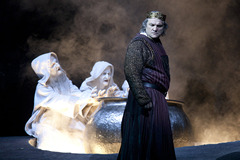| Opera Reviews | 27 April 2024 |
A musically intense Macbethby Moore Parker |
|
| Verdi: Macbeth Salzburg Festival 16 August 2011 |
|
|
In the title role, Zeljko Lucic at times touched on the greatness of bygone interpreters. His fine sense of stage work combined with a true Verdi baritone, a superb legato, and an impressive dynamic range, all combine to great effect. In some ways his reading was understated, quite devoid of hackneyed "operatic" mannerisms. Tatiana Serjan's Lady Macbeth is vibrant, and pregnant with vocal colour and nuance. While neither the dimension of her tone nor the agility in her scale work particularly dazzle (and the legato also occasionally falls foul to an excessive vibrato), the overall result is definitely imposing. Lady Macbeth's ambition and subsequent demise permeate her vocalism throughout, culminating in a well-paced finale with its finely-spun arpeggio rising to a secure high D-flat. Dmitry Beloselskiy is a Banquo to be reckoned with. An appealing and sonorous timbre with a resilient and unusually easy top, coupled with an imposing stage presence make him an undoubted asset in any Verdi production. Giuseppe Filianoti's Macduff ideally compliments the other leads. His lyric tenor has just the right weight to fit the bill, truly making his mark in "Ah la paterno mano". The remaining roles were all well filled and in fact included one member of last year's Young Singers Project - the tenor Antonio Poli, in the role of Malcolm. In terms of the staging, Salzburg's Felsenreitschule has definitely witnessed greater innovation and effect in its illustrious history. Here, a central drop with a doorway, a smoking cauldron, an illuminated table for the "Brindisi" and a gyrating leaf-clad chorus form the essence of Peter Stein's production, which is a selected combination of Verdi's original Florence and the later Paris versions. However, fine attention to period costumes (Annamaria Heinrich), and a forceful contribution from the Konzertvereinigung Wiener Staatsopenchor complimented the more positive elements of the evening, which were most warmly received at the finale. |
|
| Text ©
Moore Parker Photo © Silvia Lelli |

 This
production is, above all, a triumph for Riccardo Muti, who, after some
four decades of regular contributions in opera at the Salzburg Festival,
has announced future plans to focus on concert appearances here with
the Vienna Philharmonic Orchestra. And indeed this "swan song" (despite
the occasional minor fluff) is truly a Macbeth which dominates
through its music rather than stage reading, on the one hand intimate
in detail, and yet grand in its sweep.
This
production is, above all, a triumph for Riccardo Muti, who, after some
four decades of regular contributions in opera at the Salzburg Festival,
has announced future plans to focus on concert appearances here with
the Vienna Philharmonic Orchestra. And indeed this "swan song" (despite
the occasional minor fluff) is truly a Macbeth which dominates
through its music rather than stage reading, on the one hand intimate
in detail, and yet grand in its sweep. 





